The Jews of Kobe
by Tamar Engel
Summer
1995
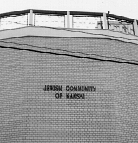
Front Wall of Synagogue in Kobe
"Jewish Community of Kansai"
Located near the entrance to Japan's Inland Sea and at the cross-roads of East and West Japan, Kobe has been a key anchorage since the 8th century and a port of significance since the late 1200's. It was known as the Port of Hyogo, and was one of the first ports open to foreign trade in the late 19th century. Kobe has since grown into one of the largest container ports in the world. Although Japan has only a small foreign population, close to 50,000 Koreans, Chinese, Indians, Americans, British, Norwegians and others live in this cosmopolitan city of 1.5 million, running important businesses, foreign restaurants, and shops that line the streets. Among these cultures, it is not surprising then to find that Jews make up a part of the multiethnic community in Kobe.
The first Jews who came to Japan were mostly traders. As such, they were naturally attracted to port areas. They arrived soon after 1862 when Japan was opened to Western commerce. By the late 1860's, around fifty Jewish families from various countries lived in Yokohama. During the 1880's, Jews also settled in Nagasaki, a port area important in Russian trade. At the turn of the century, Nagasaki was the biggest Jewish community. Kobe by that time had a functioning Jewish community with religious institutions and a Zionist organization. In 1923, Yokohama suffered a great earthquake, and later in the century, trade in Nagasaki with Russia declined, causing Jews in those communities to move to Kobe. Kobe now hosts the oldest surviving Jewish Community of Japan.
Even though Japan was far from most other Jewish communities when it first opened its gates to foreigners, it is not hard to understand why Jews ended up in Japan as merchants. Since the Diaspora, Jews have been living as a minority in diverse lands. Often, they have been denied the rights to own land, serve in the military, and take part in government. As a result, Jews made trade their main occupation. By trading, many found that they could prosper without necessarily having to settle down in one place. Constant travel trained the Jews in different cultures and languages, and left relatives scattered throughout many towns and countries, giving the Jews an edge in international trade. Thus, their long history of trading expertise made the Jews assets to countries such as Japan which hoped to advance their own economies.
Well before World War II, there was a comparatively large Jewish presence in Kobe. Trade brought both Sephardic Jews from Baghdad, Iraq and Aleppo, Syria, and Ashkenazic Jews from Poland and Russia. In addition, Russian Jews who may have been escaping pogroms also landed in Kobe. One well-known member of the community was Sam Evans (born Ewanoffsky in Odessa). He settled in Kobe in circa 1919. For many years he was a leader of the Jewish community, businessman and philanthropist. He was, in fact, the very first Jew to become a naturalized Japanese citizen. The first synagogue in Kobe was established in a rented Japanese house in Kobe. It served as the gathering place for prayer for the Sephardic Jews. Rahmo Sassoon, born in Aleppo, Syria in 1912, was responsible for the synagogue. It was named Ohel Shelomoh after Rahmo's father, Shelomoh Sassoon.
With the outbreak of World War II, Rahmo and other Jews were stuck in Kobe, unable to travel or conduct business. However, the Jews received comparatively good treatment at the hands of the Japanese authorities. For example, during the war, German officers began to appear on the streets of Kobe, causing concern mong Jews there, who had helped smuggle European Jews to safety in Japan. Under pressure from the community, Rahmo Sassoon painted over the gold letters of the Ohel Shelomoh synagogue so that the location of the synagogue would be less conspicuous. Shortly thereafter, Mr. Sassoon received in invitation to meet with the Chief of Police of Kobe. At the meeting, the Chief asked why the letters were painted over, and Mr. Sassoon explained it was because of the anxiety the community felt over the presence of German officers and Japanís alliance with Germany. The Chief told Mr. Sassoon the community had nothing to fear in Japan and ordered him to restore the lettering above the doorway to the synagogue.
The Japanese accepted a large influx of Jews into Kobe during World War II. Even though Japan was allied with Nazi Germany, the community of Kobe helped save Holocaust refugees from 1940 to 1941. Japan's policy toward the Jews was much different than that of their allies. Japanese in charge of Jewish refugees knew little about Jewish customs and practices; they took action based on the belief that Jews are very influential in the world. In particular, they modeled their view of Jews after Jacob Schiff, a Jewish financier who raised huge funds for Japan during the Russo-Japanese War in 1904. Schiff helped the Japanese tremendously and demonstrated to them that Jews are good in business and possess strong worldwide contacts. Yasue Norihiro (a.k.a. Yasue Senkoo) and Inuzuka Koreshige, leaders of the military and civilian political clique known as the Manchurian faction, hoped to attract Jews to assist in their efforts to control Manchuria. The group's goal was to develop Manchuria and its vast resources. They believed that if they treated well the Russian and Sephardic Jews, and the German refugees who came under Japanese rule, that the Jews in East Asia in turn would convince their rich and influential fellow Jews in the United States to help with war loans. Also, they hoped that Americans would look at their good treatment of the Jews and thus change its negative policy towards Japan. Finally, these Japanese also looked specifically towards the refugees from Germany as possessing crucial scientific knowledge to help Manchurian development.
Individual Japanese too helped to save the Jewish refugees for purely benevolent humanitarian reasons. Dr. Kotsuji Setsuzo, who earned a doctorate in Semitic studies from the Pacific School of Religion in Berkeley, California, was influential in allowing the Jewish refugees to settle in Kobe. Kotsuji had been a former employee of the Japanese Foreign Minister Matsuoka Yoosuke. At the end of 1940, he visited Matsuoka and asked him to permit refugees to stay in Japan. Matsuoka, after long contemplation, finally agreed to let the Jews stay as long as the Kobe local police acquiesced to their presence in the city. Kotsuji borrowed money from a rich uncle and bribed the Kobe police, who thus agreed to permit the refugees to remain in the city until they could emigrate, provided they renewed their visas on a weekly basis. The refugees naturally agreed and were thus saved from expulsion to the Soviet Union.
Perhaps the most famous person who helped save Jewish lives from the Holocaust is Sugihara Sempo, the Japanese consul to Kaunas, Lithuania, during 1940. That summer, ignoring Foreign Ministry cables ordering him to desist, Sugihara issued transit visas to about 2,140 Jewish refugees from both Poland and Lithuania. The visas allowed the fleeing Jews to take the Trans-Siberian railway to Vladivostok, and to sail from there to the Japan. These refugees were supposedly on their way to Curacao, a Dutch colony in the Caribbean, but they were permitted to stay as transit passengers in Kobe for as long as they needed. Those who could find no other third country to accept them were allowed to settle in Hongkew, the Japanese-controlled section of Shanghai, where they spent the duration of the war. Other officials who helped Jews escaping via this route include Dutch honorary consul Jan Zwartendijk, who issued at least 2,345 visas to Curacao, and Soviet officials who provided a Soviet exit visa and transit visa to reach Japan. In 1985, Sugihara, at age 85, was honored in Israel at the Path of the Righteous Gentile at Yad Vashem, and a grove was planted in his name near Jerusalem.
In Kobe, the refugees were helped by various organizations. Members of Nakada's Holiness Church came to pray for their survival. American relief organizations sent needed funds to accommodate the refugees with food and housing. Dr. Kotsuji came to interpret for them. Jews in Kobe itself numbered about fifty families when they established the Kobe Jewish Community in July 1940, and with the help of the Joint Distribution Committee in New York City, assisted the refugees to find housing, get visas, and depart for their ultimate destinations. During the years between 1939 to 1941, several thousand Jewish refugees passed through Kobe. The most famous of them were probably the three hundred teachers and students from the Mir Yeshiva in Poland. With Japan's help, it became the only yeshiva to fully survived the Holocaust. By December of 1941, when the war broke out with the United States, only a few Jews actually remained in Kobe. The rest had moved on to third countries, which mainly meant settling in the Japanese controlled Shanghai.
Shanghai already had a relatively large Jewish population of 6,000 before the war. These Jews included the affluent Sassoon's and the Kadoori's of Baghdadi origin, and later the Russian Jews who fled the pogroms. During World War II, then, refugees from all over migrated to Shanghai, and the Jewish population grew to 18,000. Compared to their fellow Jews in Europe, the Jews in the Far East were treated very well. A refugee camp for Jews, know as "Hongkew Ghetto," was established in Shanghai in 1943 and most of the Jewish refugees moved there, but these Jews were allowed to leave the ghetto during the day to work, and they were not prosecuted. The city literally saved thousands of Jews from death.
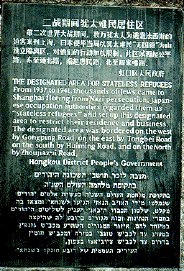
Memorial to Jews of Shanghai
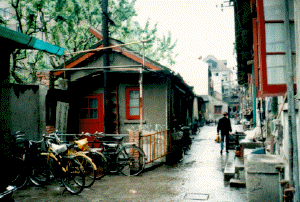
Old Jewish Neighborhood in Hongkew District of Shanghai
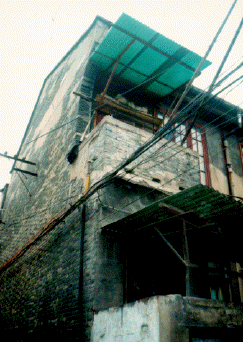
More Housing in Hongkew
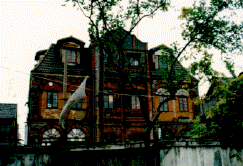
Building Used as Hospital by Refugees
During the actual war, the synagogue in Kobe was burned down in an air raid by the United States. The Sephardic congregation was forced to share space with the Ashkenazi minyan, which welcomed them. To take shelter from the air raids, most of the Jews in Kobe moved to Arima in pril of 1945. They rented a dozen bungalows that had been built by professors from the University of Kyoto, who went there during the summers. The men were able to keep a minyan uninterrupted by the Japanese authorities. After the war, many Jews left for places such as America and Israel. Some who stayed did so because they felt they could maintain good business. Others bought property after the war at extremely cheap prices, and stayed to develop their real estate.
Although the war destroyed the building where the old synagogues were situated, the cemetery on the other side of the mountain still preserves the memory of people who lived through the war. The cemetery is a true historical site. It is within an international graveyard, situated on the back side of the hill behind the synagogue. The Jewish cemetery is staggered in two areas, with the older section being lower on the hill than the newer. Inside, there are tombstones of people who came to Kobe from places from Amsterdam to Russia, from Syria to the United States, dating back to the turn of the century.
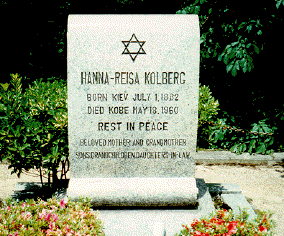
Tombstone in the Newer Section of Kobe's Jewish Cemetary
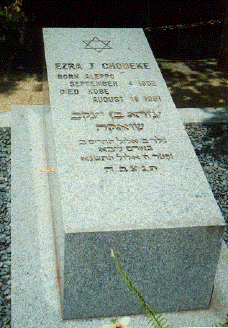
Tombstone of person originally from Aleppo, Syria
After the war, the congregation of Ohel Shelomoh found a second home. Rahmo Sassoon had bought a small lot of land and constructed a warehouse for a furniture showroom. The furniture venture did not succeed, and the warehouse was converted into a synagogue. The post-war period also brought American occupation, and Rahmo Sassoon supplied the army with many goods. David Sassoon, a cousin of Rahmo Sassoon, helped with this business. Later David Sassoon became president of David Sassoon & Co., and served during the postwar period as the biggest supplier to occupation forces. He had a Syrian passport, and Syria was officially neutral. As such he served as an important go-between for business between the Japanese and the American military. He offered them services as a third party to help with an otherwise difficult relationship. Despite the shared name, neither Rahmo nor David Sassoon were related to the well known Sassoon family that resided in Shanghai.
The present community center was built in 1970. The community raised funds to build a proper synagogue, and Rahmo Sassoon sold the land below full value to contribute to the congregation. The current synagogue is located in Kitano-cho. The Kitano Area is where most of Kobe's foreign architecture can be found. Kitano is located on a hill overlooking the city about ten minutes walking distance from Sannomiya Station, the hub of commercial activity. The area holds not only a synagogue, but a Russian Orthodox church, a Moslem mosque, and a Catholic church. At the time the present synagogue was established, the community was large and generally affluent. Quite a few Jews had once again come for trading purposes and to help participate in the modernization of Japan. Regular Hebrew school classes took place, and many social functions were held. Both Zim and Gold Star shipping companies had branch offices there. Residents included a large number of Israelis, as well as a number of Jewish businessmen, mainly in the pearl business.
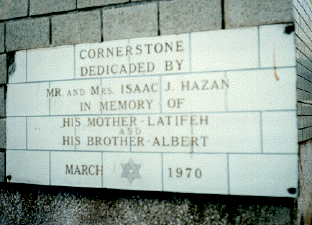
Memorial with date Synagogue was Established
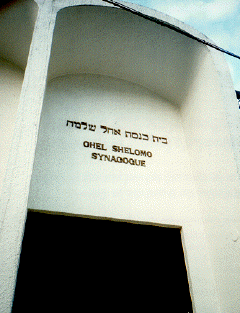
Current Synagogue's Entrance
The Jews who prospered during those times did so because Japan needed help to develop into the modern economy that it has become. The Japanese found value in the Jews, who helped them establish many businesses, connections, and technology. It wasn't long, however, before the Japanese had advanced in technology, gained their own connections, and opened their own companies and investments in foreign countries, thus having less need for the foreigners whom they at first depended upon. The "endaka", meaning the sudden appreciation of the yen in the late 80's, caused serious difficulties for foreigners trying to do business in Japan. Both Zim and Gold Star, for example, closed their Kobe offices. Many others, too, closed their businesses, and about 30 families went back to their home countries to retire.
The earthquake of January 1995 also caused a lot of hardships for the Jewish Community of Kobe. Many members lost their homes and their possessions. They were forced to move from Kobe, and to rent homes in other places such as Nara and Osaka giving Kobe time to be cleaned up and rebuilt. One member owned an apartment complex near the synagogue, but because of severe earthquake damage, it had to be torn down. He moved to Israel. Also, those members who lived further away found it difficult to get to the synagogue every Saturday. The synagogue itself suffered damage during the earthquake, and the front wall needed repair. The nearby Jewish cemetery too suffered damage, as certain tombstones were cracked. The community has received donations from various people, including a third grade group of B'nai Brith members who held a read-a-thon to raise funds, and a New Yorker who is a nephew of a man buried in the cemetery. However, the cost of repairs is high, and the community is still striving to raise funds to help in restoring the synagogue to its original strength.
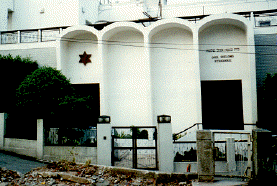
View of Side Wall of Synagogue
Earthquake Rubble Visible in Front
In spite of the drastic decline in population, the present members of the Kobe community are a diverse, active group of people. The permanent residents who number 70 from all over Kansai including Osaka, Kyoto, and Nara, come originally from New Zealand, the UK, the USA, Canada, France, Israel, Syria, Iran, Morocco, Iraq, the Dominican Republic, and elsewhere. The synagogue is an orthodox one, allowing Jews of all orientations to participate in services and holidays. Every Shabbat all participants are invited to a full sit down kiddush complete with cholent, salads, challah, wine, and beer. Anyone who joins the kiddush might hear Japanese, Hebrew, English, French, German, and Persian all within the time span of one meal.
The Jewish community in 1995 was also active in adding to the overall atmosphere of Kobe. Members each seem to have their own claim to fame. Several were in the pearl business, with their head offices in Kobe, which is known is a world leader in the fresh pearl trading business. Others have also added to the variety of restaurants to be found in Kobe. One member for ten years ran a Mediterranean style restaurant before switching over to the pearl business. Another named Simon Elmaleh actually was the president of the Jewish community in 1995 and ran a Moroccan style restaurant called Marrakech. The community included some of the few people selling Persian carpets in Japan, Jay and Sumi Gluck, and students and teachers from Israel and the United States. It even included the Japan representative competing in Judo for the Maccabi Games of 1985 and 1989.
Visitors to the community of Kobe are diverse. Hasidim with their black coats and payes come to Kobe every once in a while to help run services. This Passover, for example, two young rabbis came from New York to run the seder, and they brought matza shmuura to add to the meal. Families on vacation from other parts of the world often stop in to visit the synagogue. Also, there are quite a few young Israelis who sell jewelry and other goods in street markets, and utilize the synagogue on main holidays. On December 13, 1994, Itzhak Rabin, Israel's Prime Minister, visited the synagogue of Kobe. He came to Japan to speak of the Peace Talks between the Arab nations and Israel, and to help gain Japanese support for Israel. Recently, entertainers have come to add to the Jewish Community in Kobe, as The Hyogo Performing Arts company put on in June and July of 1995 a play called "Ghetto," at the Shin-Kobe Oriental Theater. The play features the music written by the Inhabitants of the Vilna Ghetto during 1943.
The Jewish Community of Kansai is probably one of the most diverse congregations in the world. Although it is small, the history that it holds is strong and unique. The community has survived through many hardships, and hopefully it will thrive for a long time to come. May you too soon have the chance to be one of the many visitors to the community.
Address:
The Jewish Community of Kansai
Synagogue Ohel Shelomoh
4-12-12 Kitano-cho
Chuo-ku
Kobe 650
JAPAN
tel (078) 221-7236
fax (078) 242-7254
Other links that refer to the Kobe Synagogue:
∑† Am Yisrael
Other sites on the web to check out:
∑† Shamash: Serving the Jewish Internet
Special thanks to David Sassoon, son of Rahmo Sassoon, for providing notes on the history of the Kansai Jewish Community in Kobe
Tamar Engel tamar at the domain that is cs dot stanford dot again edu Note this article was written in 1995 and as such some information may be outdated. Feel free to contact me for revisions or questions.